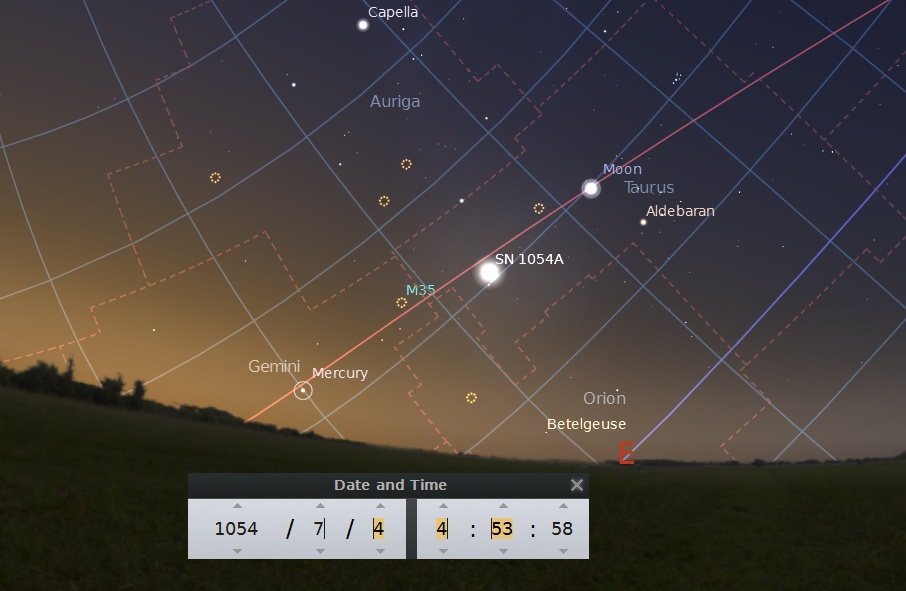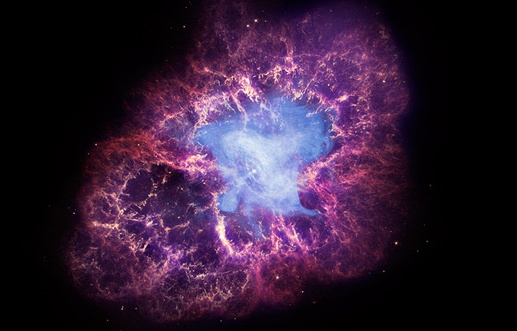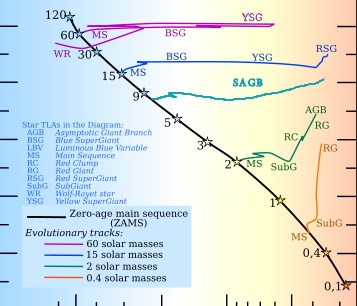

The First Messier Object
It was July 4th 959 years ago, a couple hours before sunrise. The moon was thin sliver about 20 degrees above the horizon. A glow in the east heralded a coming dawn. But between the sun and moon was a new star, blazing three times brighter than Venus. And for 23 days, this guest star was visible in the daytime sky. The supernova of 1054 reached a magnitude of -6 and remained visible for 650 days before fading below naked eye limit.

Stellarium Screenshot
Supernova 1054 didn't reappear for another 675 years when John Bevis, English doctor and amateur astronomer, spotted the Crab Nebula through his telescope. Charles Messier spotted it again in 1758 and added it to his collection of objects that are not comets. It became Messier 1, the first object in his catalog of things to ignore. In 1939 the object was associated with the supernova of 1054. And in 1968 a pulsar was discovered at the heart of the Crab Nebula.
With a neutron star at its heart and an expanding shell of gas, M1 became the prototype for a type II supernova and led astronomers toward an understanding of core collapse supernovae. The explosion of SN1987a 26 years ago in the Large Magellanic Clouds served to confirm most of the theories of the end stages of massive star evolution. And just when it was all figured out, new observations and theoretical calculations hinted that SN1054 was not a typical core collapse supernova at all. It's too bright, not massive enough, and too slow.

Composite of x-ray, optical, and infra-red from Chandra space telescope NASA
The precursor star to SN1054 is not on ancient star maps. If it had been a red supergiant star it should have been bright enough to see, even at more than 6000 light years. If it was an assymptotic giant branch star, it could have been near the naked eye limit or just a bit dimmer. It was assumed that the assymptotic giant branch couldn't quite make it to the core collapse stage, but instead would produce nice planetary nebulas after ejecting their outer layers, then shrink to white dwarves. When the mass of the remnant is added up, you only get 5 solar masses at most. There should be more. And the expansion rate of the remnant is too slow giving only one tenth the energy expected from an iron core collapse supernova. But this low energy event produced a supernova with -18 maximum absolute magnitude. That's too bright. And it stayed visible for 650 days. It should have been visible less than half as long.
Back at the drawing board astrophysicists came up with a new supernova mechanism -- the electron capture supernova. A degenerate oxygen-neon core undergoes a process wherein neon and magnesium atoms capture electrons and radiate energy away in the form of neutrinos. The core cools, collapses, and a neutron star core is born, blowing the rest of the star apart. It should create a fainter supernova than a normal iron core collapse supernova. The fusion products in the remnant fit this scenario. To solve the brightness problem, it seems there must have been a significant and relatively quick mass ejection from the star in just a few hundred years before the supernova. In that case, the ejected matter would heat up and radiate enough energy for it to have been a bright supernova. The length of time the remnant was visible is still a question mark, but may again be related to the ejected shell dynamics.

This new mechanism would probably affect stars in the 7 solar mass to 9.5 solar mass range. These stars follow the Super Asymptotic Giant Branch (SAGB) when they leave the main sequence. And since stars in this mass range are more common than extremely high mass stars, this type of supernova may in fact be relatively common. But according to simulations, the amount of heavy elements in the star to begin with, the exact mix of Neon and Oxygen in the core, and whether the core burns symmetrically may all determine whether the stars ends up as a supernova or a white dwarf. But even the white dwarf could end up as a type Ia supernova if there is a close orbiting companion star, since it would be near the mass limit for white dwarfs.
